At a time when it has become difficult to count our blessings and have a positive outlook on life, it is crucial for a nation to look for causes to celebrate. As we end 2004, SWM takes a look into this eventful year and selects a number of achievers who have shown that talent combined with determination and hard work can bring about amazing results. These individuals represent the brand of people who have managed to keep the flicker of hope for our country alive and flaming.
Amrao Pari
Abul Khaer and the Emmy
Best known for its political instability and natural disasters, Bangladesh has surprised the world when "Amrao Pari" (We, too, Can), a documentary directed, shot and edited by 18 Bangladeshi teenagers has won the 32nd Academy of Television Arts and Science (EMMY) Awards.
 Abul Khaer, the protagonist of the documentary, is himself a hero in real life. On an early July morning in 1996, the nine-year-old stopped a passenger train that was approaching a disjointed track at the Boaljhuri Railway Bridge.
Abul Khaer, the protagonist of the documentary, is himself a hero in real life. On an early July morning in 1996, the nine-year-old stopped a passenger train that was approaching a disjointed track at the Boaljhuri Railway Bridge.
"At that time I had 20 ducks and ducklings, which laid around 18 eggs a day. My father was a day labourer and apart from him, these eggs were the only source of income for us. Every day I woke up early in the morning to collect snails and oysters for the ducks," Khaer recalls. While browsing through stones on the rail track, near the Toraghar crossing, Khaer discovered a part of the rail line disjointed.
"I tried to reunite the tracks by hand, but failed," he continues, "Then I realised that the Chittagong bound Antanagar Meghna was going to come within 10 minutes or so." He shouted for help, but no one came.
Khaer knew he would be able to stop Antanagar Meghna if he could wave anything red to the driver. The child, who would later drop out from school because of sheer poverty, ran home and brought his aunt's red petticoat. When he went up the track, waving the red cloth, the train was only 200 metres away.
The train, however, stopped. "But the driver was extremely furious," Khaer recalls. "He yelled at me and asked why I was waving a red cloth at the train," Khaer smiles, and looks at the young team that recreated the whole incident on film to win this year's prestigious EMMY.
Half the 18 teenagers of the EMMY-winning group were already household names by their participation in ETV's Muktokhobor. When the television channel went off air, these children, along with the programme's producer Rowshon Ara Rukhsana Sirkar Nipa, decided to join ATN.
"Nipa apa called and told us not to quit filmmaking," Robiul Islam Raju, who went to Boaljhuri, Chandpur, for shooting says. In fact, Mahfujur Rahman, ATN-Bangla's chairperson, grabbed the idea when Nipa submitted her project proposal.
"He immediately approved it and named it Amra Korbo Joy," Nipa says, "Eighteen children, half of whom are underprivileged, work with this programme. And our motto is, 'By children, for children, to everyone'."
Broadcast at 6:30 every Friday evening the programme has become an instant hit among the channel's young audience. The children get a monthly allowance of Tk 3,000 each.
"It was Tk 1500 in ETV. Then again we worked only seven days a month at that time. Now we work two weeks in a month," Fateema Akhtar, another cub reporter and a student of Mirpur Technical College, says. "Every month I save something from my allowance and send it to my parents in the village," she continues.
When UNICEF wanted the team to make a documentary for the World Child Broadcasting Day, the group decided to focus on Abul Khaer. Two members of the team, along with their producer and two other adult members went to Khaer's home in Hajiganj to re-enact the incident.
Guided by Nipa and other adult members of the ATN staff, the children did most of the direction, cinematography and editing. "We operated the camera and sat with the editor. We took all the editing decision by ourselves," recalls Khairul Amin Nahin, one of the cinematographers of the team. Nahin, a student of Dhaka College, was not in Muktokhobor; he joined Amra Korbo Joy after undergoing a one-month training course.
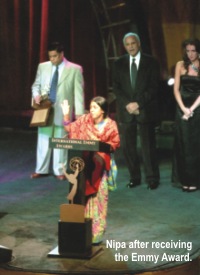 When it was made, Rezwanul Haque of UNICEF Bangladesh advised the team to send it to International Children Day of Broadcast (ICDB). On 14 October this year, the film was nominated for EMMY-UNICEF Award. The other three documentaries that got nominations in this category were produced by Lao National Television, Walt Disney China and National Television Kenya.
When it was made, Rezwanul Haque of UNICEF Bangladesh advised the team to send it to International Children Day of Broadcast (ICDB). On 14 October this year, the film was nominated for EMMY-UNICEF Award. The other three documentaries that got nominations in this category were produced by Lao National Television, Walt Disney China and National Television Kenya.
The award was declared on November 22. In the other nine categories, BBC and Channel Four grabbed the most awards and MTV got a special award for its HIV/AIDS campaign.
Though the documentary is littered with editing and directional flaws, critics believe it was the film's humane touch that has won it the award.
Things, however, had remained unchanged very little for Abul Khaer till the making of Amrao Pari. In 1996, to recognise his bravery, the government gave Abul Khaer a lump-sum amount of Tk 2,500. Though the Chandpur District Administration had promised to give his family an abandoned acre of government land, it has never been kept. The boy had to quit study and all the duck and ducklings the family had raised died too.
When Amra Korbo Joy team came back to Dhaka they told the ATN authorities about Khaer's plight and the channel employed him first as an office peon this year, then as an assistant cameraman.
- Ahmede Hussain
Aref Chowdhury (Rubel)
A Young Innovator
For Aref Chowdhury (Rubel), three years as a researcher at Bell Labs was not just another job, it was a life-altering experience through which he earned acclamation within the scientific world. On September 20, 2004, MIT's magazine, Technology Review named Chowdhury one of the top 100 young innovators of the world. Innovators under thirty-five were nominated for their help in transforming the nature of technology and business in industries such as biotechnology, computing and nanotechnology.
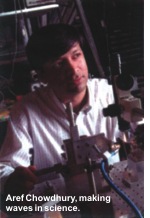 Chowdhury, along with his 99 other counterparts was honoured on September 29-30 at Technology Review's 'Emerging Technologies' conference in Cambridge, Massachusetts in the United States, in which the subject of discussions was on the technological innovations that have the potential to fuel new economic growth and change.
Chowdhury, along with his 99 other counterparts was honoured on September 29-30 at Technology Review's 'Emerging Technologies' conference in Cambridge, Massachusetts in the United States, in which the subject of discussions was on the technological innovations that have the potential to fuel new economic growth and change.
Chowdhury has a bachelor's degree in Engineering, with Honours in Electrical Engineering and Applied Mathematics and Statistics from the State University of New York, Stonybrook, and a Ph.D in Electrical Engineering from the University of Wisconsin-Madison. While he was there, Technology Review recognised Chowdhury's work on nonlinear photonic crystals, where he designed and fabricated nonlinear photonic crystals that could be used to switch date between individual wavelengths of light when routing information optically.
Bell Labs is the Research and Development division of Lucent Technologies, which designs and delivers the systems, services and software that drive next-generation communications networks. It has played a pivotal role in inventing and perfecting key communications technologies, including transistors, digital networking and signal processing, lasers and fiber-optic communications systems, communications satellites, cellular telephony, electronic switching of calls, touch-tone dialing and modems.
Chowdhury's field is nonlinear optics and biochemical detection research. On the prestigious title he has been given, Chowdhury says, "It is a great honour to be recognised, but a lot of the credit goes to my research colleagues. I feel very lucky to work with world-class scientists here at Bell Labs on research that can positively impact Lucent and beyond."
Director of Quantum Information and Optics research at Bell Labs, Dick Slusher has some thoughts to share, "Aref is representative of the calibre of a scientist hard at work on problem solving, significant research challenges here at Bell Labs. He joins a great group of Bell Labs alumni that have won this award in previous years and we applaud his accomplishments."
Aref Chowdhury's accomplishments serve as a source of inspiration for not only young innovators, but also young Bangladeshis everywhere. He is the living proof that hard work and determination eventually helps one win the race. His work is not only praised by his immediate colleagues and co-workers, but has been recognized internationally as a means to change and transform the future of science and technology, thereby impacting the world we live in positively.
-Srabonti Narmeen Ali
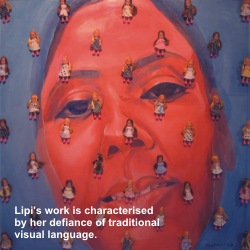 Self-Analysis
Self-Analysis
Lipi's Visual Solution
Projecting one's childhood on the canvas is something of a challenge for any artist, as the murky hue of nostalgia always plays havoc with the artistic verve by making it too moody or glum. For Tayeba Begum Lipi, childhood memories serve to express the usual visual verve, as she brings them on to put forward a statement. Childhood, in her work, gets a new lease on life and meets the artist's current self-portrait. This union of the present and the past has fetched Lipi the Grand Prize at the 11th Asian Biennale of Bangladesh Shilpakala Academy in January 2004.
Lipi says her entry into the arts was by accident. Tayeba, after passing out from college in 1986, came to Dhaka to seek admission in the journalism department of the Dhaka University. The moment she entered the walled area of the Institute of Fine Arts, she was taken by the beauty of its setting and environment. Disregarding her parents' advice and shunning her art student brother's outrage, she sat for the entrance examination and was allowed admission.
In 1991, when she was introduced to oil colour in her drawing and painting department her enthusiasm was boosted. "At this point I realised that I would certainly become a painter," exclaims Tayeba remembering her struggle in the early years in the Institute of Fine Arts while trying to find a foothold in the domain of art.
Around 1995, she got a chance to attend an artist camp in Nepal. There she met young artists from the subcontinent, and it was at this time that she was introduced to all the different aspects of art. She did a lot of landscapes there, which contributed to her development in handling oil.
As she gradually woke up to the fact that art is not merely confined to the boundary of the frame of a canvas, she felt liberated. Art as an easel painting had been her fixation, but in Nepal her ideas were given a thorough shake, when she had seen young artists experimenting with space and objects defying traditional visual languages. She felt at home with the new mode that tends to extend the border of the very concept of art.
She came back to Dhaka with her enthusiasm enhanced and confidence reinforced. The change that affected her translated into her paintings; she started to put falling and contorted female figures against a vegetation-rich landscape.
Though her paintings at that time exteriorised a feeling of outright confidence, they were markedly different from what she would later embark on. In the second part of her Masters of Fine Arts, she had fully realised her goals: it was to formulate a socially relevant language of art. To fulfil that ambition she juxtaposed static female figures that resembled mannequins. She had in mind the emancipation of women. So, it was fashion and trend that became the subject that she poked fun at. Her female forms were depicted frozen alongside the paraphernalia of the dorjee, (tailor) to suggest conformity.
With the language of art, she herself became a nonconformist. In the new millennium, her art boldly tackled ideas that tossed her into the limelight. She started to use her self-portrait, and combined realistically executed paintings with installed objects, human dummies and so on to formulate a voice of socio-political significance.
 Lipi likes to believe that her sojourn in Ireland had created opportunities she otherwise might have overlooked. She was awarded residency for three months. "My ideas reached maturity in Ireland as I was exposed to a lot of stimulation and I also had the time to generate ideas of my own," says Tayeba. In a show by Lipi and her artist husband in 2002, Tayeba's Toy Watching Toys was all the rage, where her three big realistic portraits were presented vis-a-vis burkha-clad dummies fashioned after herself. In the last solo that she called "Even The Walls Have Ears", she mixed together video installation with two-dimensional images.
Lipi likes to believe that her sojourn in Ireland had created opportunities she otherwise might have overlooked. She was awarded residency for three months. "My ideas reached maturity in Ireland as I was exposed to a lot of stimulation and I also had the time to generate ideas of my own," says Tayeba. In a show by Lipi and her artist husband in 2002, Tayeba's Toy Watching Toys was all the rage, where her three big realistic portraits were presented vis-a-vis burkha-clad dummies fashioned after herself. In the last solo that she called "Even The Walls Have Ears", she mixed together video installation with two-dimensional images.
Tayeba had to struggle in real life to overcome financial snags. Since the beginning, she and her husband took up art as their only pursuit, now the two shepherd an organisation named Britto. At present she remains at the helm of this artists' trust as its director. As for her fight to overcome personal obstacles, it is intrinsically bound with her struggle to find an artistic language of her own. Currently she has been awarded a year round Scholarship from the Artist Aminul Islam Trust. Throughout her journey she carries all the emotional baggage that make up her personality. Perhaps that is how she so easily confronts her self-portraits in the form of her work.
-Mustafa Zaman
Abdullah Abu Sayeed
An Enlightened Man Recognised
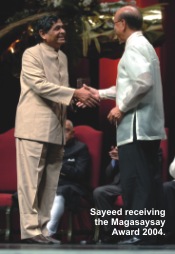 Litterateur cum teacher cum television presenter Abdullah Abu Sayeed hardly needs an introduction. While he has a strong claim of eminence in all of these fields, his most enduring creation is the Biswa Shahitya Kendra (The Centre of World Literature). Since the early seventies, Sayeed has led nothing less than a revolution with Alokito Manush Chai (Creating Enlightened Individuals), a mission he has been pursuing for the last three decades.
Litterateur cum teacher cum television presenter Abdullah Abu Sayeed hardly needs an introduction. While he has a strong claim of eminence in all of these fields, his most enduring creation is the Biswa Shahitya Kendra (The Centre of World Literature). Since the early seventies, Sayeed has led nothing less than a revolution with Alokito Manush Chai (Creating Enlightened Individuals), a mission he has been pursuing for the last three decades.
Professor Sayeed's remarkable work has won him many accolades besides his disciples' respect, but this year he brought both for himself and Bangladesh a unique honour when he won the prestigious Ramon Magasaysay Award 2004, also dubbed as the Nobel in Asia. In its citation the Ramon Magasaysay Foundation emphasised Sayeed's "contributions to his cultivating in the youth of Bangladesh a love for literature and its humanising values through exposure to great books of Bangladesh and the world". Besides, his contributions to journalism, literature and creative communication arts were also mentioned in the citation when Prof Sayeed accepted the award in an elaborate ceremony in Manila, the capital of the Philippines.
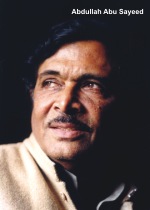 Professor Sayeed believes that a good book contains thoughts, dreams, visions, beauties and all the precious things mankind has created both in the past and the present, so by exposing young people to the greatest books of the world he wanted to create "The Enlightened Individual" for which he has devoted all his energies. The Biswa Sahitya Kendra with its amazing collection of books both Bangla and Bangla translation of many world masterpieces have contributed to the intellectual upbringing of an entire generation of youth, but, more importantly, he has succeeded in reviving the almost dying culture of reading among young people. BSK is not just a library where one goes to read books, it has also developed a network among many of the schools across the country so that students of those particular schools have access to the BSK collections. The centre has also initiated mobile libraries, the first of its kind in the country, which go to different specified places in the city following a particular schedule, thus allowing interested readers, who cannot make it to the library, to borrow books virtually from their doorsteps. Though BSK's principal focus is on reading books it also arranges workshops on filmmaking, photography, creative writing etc and organises film shows and a variety of cultural shows for of the intellectual development of the youths.
Professor Sayeed believes that a good book contains thoughts, dreams, visions, beauties and all the precious things mankind has created both in the past and the present, so by exposing young people to the greatest books of the world he wanted to create "The Enlightened Individual" for which he has devoted all his energies. The Biswa Sahitya Kendra with its amazing collection of books both Bangla and Bangla translation of many world masterpieces have contributed to the intellectual upbringing of an entire generation of youth, but, more importantly, he has succeeded in reviving the almost dying culture of reading among young people. BSK is not just a library where one goes to read books, it has also developed a network among many of the schools across the country so that students of those particular schools have access to the BSK collections. The centre has also initiated mobile libraries, the first of its kind in the country, which go to different specified places in the city following a particular schedule, thus allowing interested readers, who cannot make it to the library, to borrow books virtually from their doorsteps. Though BSK's principal focus is on reading books it also arranges workshops on filmmaking, photography, creative writing etc and organises film shows and a variety of cultural shows for of the intellectual development of the youths.
Youthful even at 60 plus, Sayeed's energy is still in great supply. He can often be spotted in the front line of a small procession holding banners that read "Save the Buriganga" or "Want Safe streets" or "Beware of the Deadly Dengue". In spite of his stringent daily routine he has time to take the streets for a good cause or utilise his celebrity status to create mass awareness about anything that will benefit people.
-Shamim Ahsan
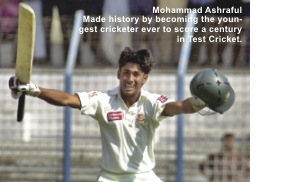 Mohammad Ashraful
Mohammad Ashraful
The Cricketing Sensation
Cricket is a game that requires a touch of skill, a dash of talent, a fistful of determination and a bucket of hard work. These are the essential ingredients of being an international star in the realm of cricket and Mohammad Ashraful is an upcoming talent who has all this and more. Ashraful was born on 9th September, 1984 in Dhaka. Making a name in the cricketing arena, he made history by becoming the youngest man, or boy, ever to score a century in Test Cricket at the tender age of sixteen. This was the fastest hundred for any Bangladeshi and more so, it was his debut against match against Sri Lanka. He shared the Man-of-the-Match award with Sri Lanka's Muttiah Muralitharan that day. But life was not always so. He started his career at a very young stage, a leg spinner who was also good at batting. He soon joined the under 19 team and from there, quickly shot up to the Bangladesh national team. Since then, every minute has been a sensational adventure. Ashraful is an aggressive middle order batsman and is one of the shining stars of Bangladesh cricket. After Bangladesh's tour of Sri Lanka in 2002 Ashraful was benched for quite sometime. However, after his undisputed contribution of 108 in the Patron's Trophy for Bangladesh "A", Ashraful was back into the national team. In his comeback match he scored a remarkable 98, only to be undone by the magical bowling of Heath Streak.
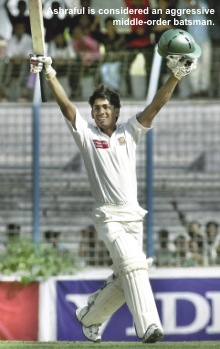 Ashraful, still in his learning stage, is now a talented batsman. He has made a reputation of playing all kinds of shots in the book but has a knack of throwing away his wickets at odd times. The only thing to account for this is his youthful impulsiveness. He showed what he was made of this December 2004, when he scored his second century - a colossal 158 not out - against the Indian cricket team during their tour of Bangladesh. Ashraful now holds the record for the highest individual test score by any Bangladeshi. It was an inning of rare brilliance for Ashraful, a milestone in his career. He had won the battle but the war was lost, as Bangladesh lost to India that day.
Ashraful, still in his learning stage, is now a talented batsman. He has made a reputation of playing all kinds of shots in the book but has a knack of throwing away his wickets at odd times. The only thing to account for this is his youthful impulsiveness. He showed what he was made of this December 2004, when he scored his second century - a colossal 158 not out - against the Indian cricket team during their tour of Bangladesh. Ashraful now holds the record for the highest individual test score by any Bangladeshi. It was an inning of rare brilliance for Ashraful, a milestone in his career. He had won the battle but the war was lost, as Bangladesh lost to India that day.
Sunday night on December 26 was a night to rejoice as the Bangladesh side wrote a new chapter in their history. They took on the visiting Indian team in the second ODI and won. Mohammad Ashraful gave a stunning performance whacking two sixes and one four in a fine 28 runs off 48 balls. This was their first victory on home turf and it came on their 100th ODI. The whole stadium exploded with not just the audience there, but also the millions on television all over the country, backing their team as they inched their way to victory.
Ashraful is the 'new kid on the block' and he is here to shake things up.
-Imran H. Khan
 Momtaz
Momtaz
The Music Queen
Hers is not the typical Bangali woman's soft, mellow voice, it's rather slightly on the rough, husky side. The lyrics of her songs are not exactly refined, but often colloquial, sometimes even rustic. But it is with that unconventional combination that she achieves a distinct quality that the audience finds irresistible. Her strength doesn't lie in the soothing effect on the ear, rather she kind of stirs up the audience's heart and demands their response. Thus when she comes on stage the audience goes into a frenzy and when she sings out the audience invariably joins in chorus. Her infectious charm and undeniable talent has made her one of the most popular entertainers of the country. With an unbelievable 600 audio albums to her credit she is unarguably the most adored singer of the country. At a time when band musicians are the craze in live concert shows she is indeed the biggest crowd puller.
Mumtaz Begum's initiation into music occurred early. She was a mere child when she accompanied her singer father Modhu Boyati at first as an audience but very soon as a co-performer. Her father aside Matal Razzaque Dewan was another of her guru who she considers her mentor. She took to music almost unknowingly, but then she must have dipped deep into the sea of music and come out intoxicated, for ever. She never looked back again and never even distantly thought of doing something different. The kind of music she used to perform like Marfati, Boithoki, Murshidi can roughly fall under the genre of mystic songs.
It was not always rosy though. There were also occasions when she did albums entirely free of cost and when those albums became popular the producer offered her Tk 2,000, not for the ones she had already done, but for the one she would do next. That too on the condition that if it didn't sell well she would be bound to pay the honorarium back. Mumtaz didn't have to pay back-- the album sold out instantly and suddenly Mumtaz became extremely busy. At times she was recording two albums a day. "I used to be handed down the lyrics and the music tracks minutes ago and there used to be hardly any time for rehearsal and I had to record it at one go," she reveals in an interview with the Daily Star last May. Some of her most famous music albums include Return Ticket, Ashol Boithoki, Murshider Talim, Ronger Bazar etc.
Though Mumtaz sings other varieties than those of mystic songs her concentration remains there. One of Mumtaz's great achievements has been to broaden the audience base of mystic songs which has been largely confined to rural areas and rural people. And most surprisingly today's middle class urbanite youths also make a part of her fans.
As a person Mumtaz is a woman of great kindness who is ever ready to extend a helping hand to people who come to her. She was an active supporter in the establishment of an eye hospital in her native Shingair village.
- Shamim Ahsan
 Asheque Elahi Shams
Asheque Elahi Shams
Acting the O's
“Getting an 'A' in Bangla was a big shock for me!" exclaims Asheque. The tall and slim youngster with black rimmed glasses seemed very indifferent to the fact that he actually got a total of 11 'A's in his O level examinations held in the year 2004, the highest this year and the second highest so far, after Rezwan Haque, who got a total of 12 'A's in 2003, the highest in the world. A student of South Breeze School, Dhaka, Asheque Elahi Shams made his family, friends and school proud with his outstanding results, and clinched the Daily Star Award as well.
Asheque had taken on a total of 11 subjects in two sittings, comprising of Bangla, English, Economics, Accounting, Computing, Commerce, Pure Math, Biology, English, Chemistry and Physics. "I was terrified during my Bangla exam and was really bewildered with the result actually," says Asheque. "I had never really done all that well in my mock exams at school and truly speaking, never had much hope in Bangla, especially grammar. I had registered for some of the subjects just a month or so before the exam," he goes on. "I had major problems with my project in Computing and never realised that I would get an 'A' in it."
Asheque claims to be an average student, just like any other from his class. "I am actually very lazy and simply cannot think of studying for hours at a stretch," says Asheque, revealing his study secrets. "I did everything at the very last moment and never really went to all the trouble of studying beforehand. I did take extra help and would go for tuition for certain subjects. However, I also watched a lot of TV, watched movies and had fun as well. I think studying right in the end helped me remember everything."
Did he feel absolutely delighted with his results and the fact that he had the highest score this year? "Not really," he replies. "Everyone in my class got all 'A's in the subjects they registered for. In fact, I think this year we had some of the best students in the batch. Though I did feel happy about my grades, since they will help me get into a good college now."
Asheque is now working hard for his A-levels and looks forward to studying in Princeton University. "I do plan to com back to my country after my studies," informs Asheque. "I hope everyone does, for that matter."
- Elita Karim
Copyright (R) thedailystar.net 2004
No comments:
Post a Comment